Analysis of SABIC Leadership Approach and SLW Program Implementation
VerifiedAdded on 2022/09/26
|9
|1794
|37
Report
AI Summary
This report provides an in-depth analysis of the leadership approach at SABIC, a prominent chemical manufacturing company based in Saudi Arabia. The report focuses on the SABIC Leadership Way (SLW) program, initiated in 2017, which aims to cultivate a strong leadership culture within the organization. The SLW program emphasizes four key priorities: talent development, collaboration, innovation, and driving excellence. The analysis explores how SABIC's leadership initiatives, including the SLW program and HR tools, have influenced workplace culture, employee engagement, and the company's ability to achieve its goals. Furthermore, the report identifies strengths and offers recommendations for further enhancing leadership effectiveness, emphasizing the importance of continuous learning, collaborative partnerships, and integrating the leadership way program with leadership development to ensure that SABIC remains competitive in the global market.
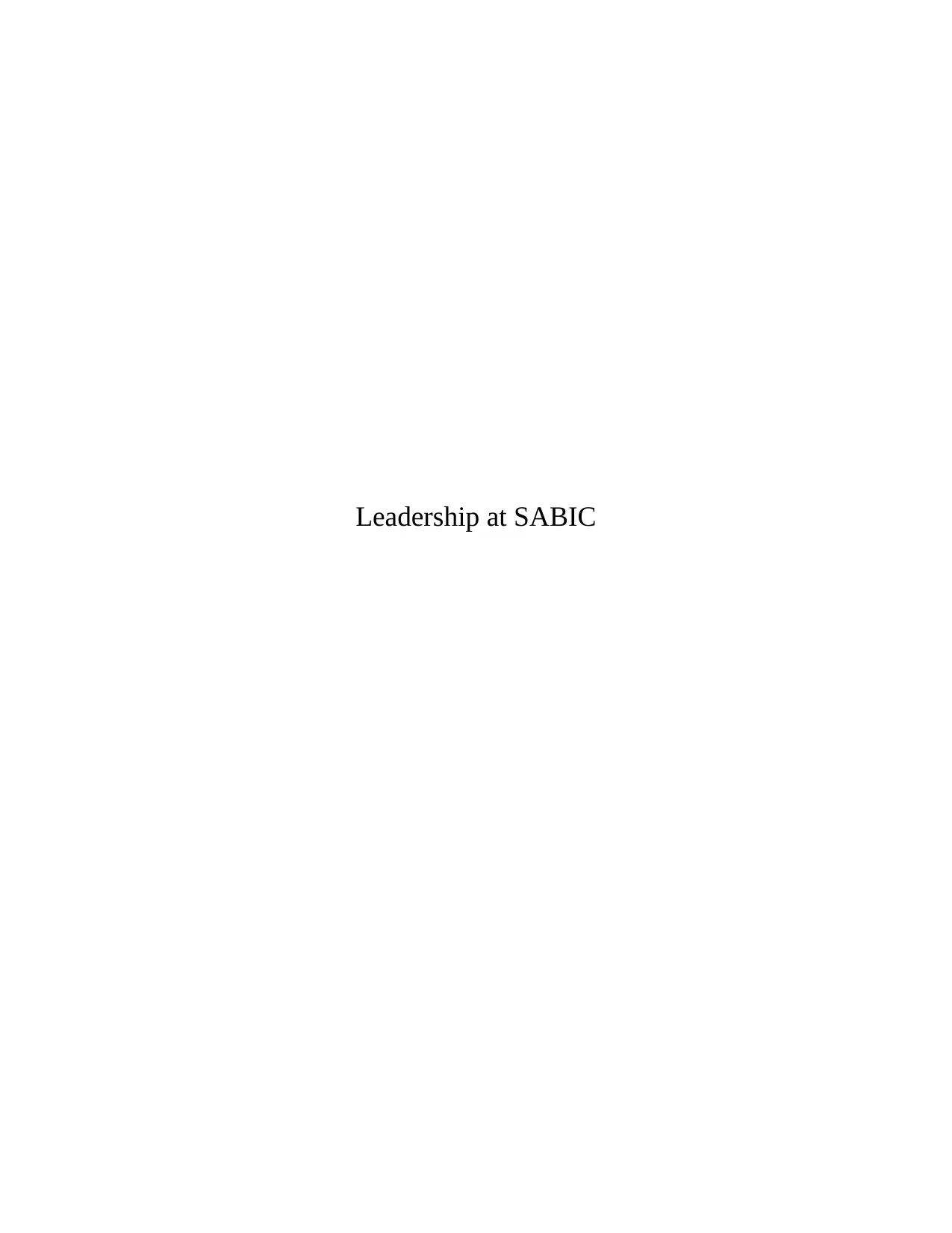
Leadership at SABIC
Paraphrase This Document
Need a fresh take? Get an instant paraphrase of this document with our AI Paraphraser
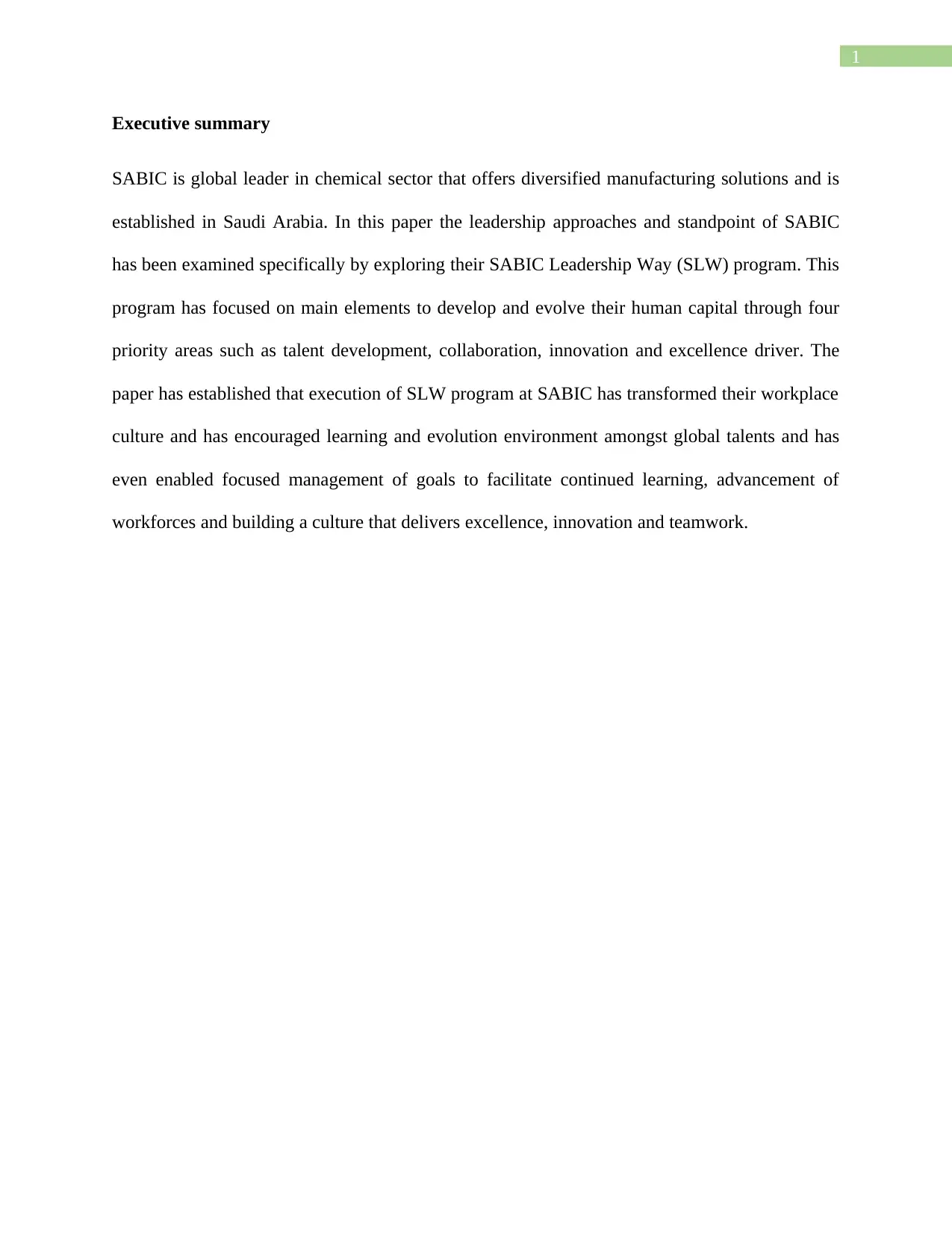
1
Executive summary
SABIC is global leader in chemical sector that offers diversified manufacturing solutions and is
established in Saudi Arabia. In this paper the leadership approaches and standpoint of SABIC
has been examined specifically by exploring their SABIC Leadership Way (SLW) program. This
program has focused on main elements to develop and evolve their human capital through four
priority areas such as talent development, collaboration, innovation and excellence driver. The
paper has established that execution of SLW program at SABIC has transformed their workplace
culture and has encouraged learning and evolution environment amongst global talents and has
even enabled focused management of goals to facilitate continued learning, advancement of
workforces and building a culture that delivers excellence, innovation and teamwork.
Executive summary
SABIC is global leader in chemical sector that offers diversified manufacturing solutions and is
established in Saudi Arabia. In this paper the leadership approaches and standpoint of SABIC
has been examined specifically by exploring their SABIC Leadership Way (SLW) program. This
program has focused on main elements to develop and evolve their human capital through four
priority areas such as talent development, collaboration, innovation and excellence driver. The
paper has established that execution of SLW program at SABIC has transformed their workplace
culture and has encouraged learning and evolution environment amongst global talents and has
even enabled focused management of goals to facilitate continued learning, advancement of
workforces and building a culture that delivers excellence, innovation and teamwork.
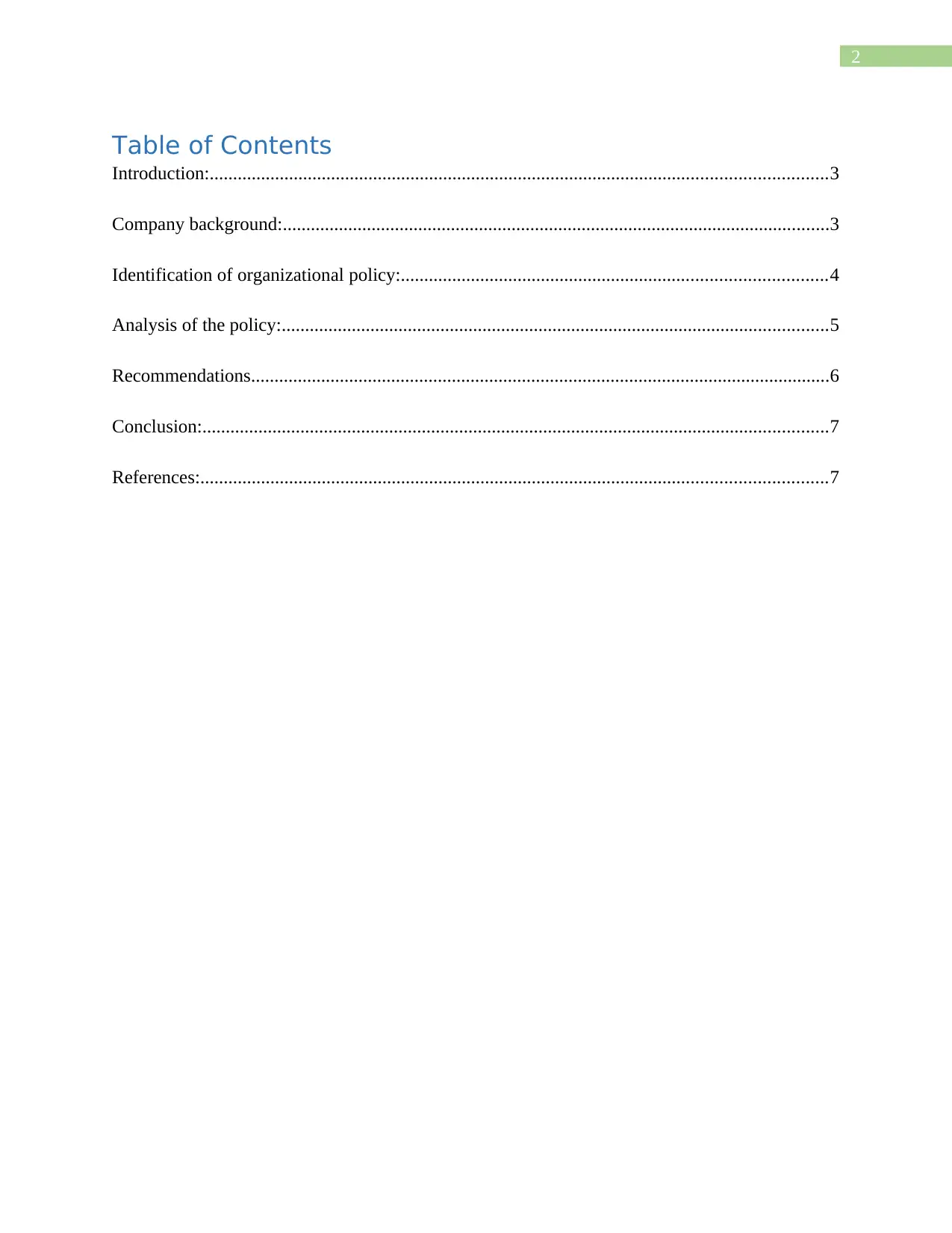
2
Table of Contents
Introduction:....................................................................................................................................3
Company background:.....................................................................................................................3
Identification of organizational policy:...........................................................................................4
Analysis of the policy:.....................................................................................................................5
Recommendations............................................................................................................................6
Conclusion:......................................................................................................................................7
References:......................................................................................................................................7
Table of Contents
Introduction:....................................................................................................................................3
Company background:.....................................................................................................................3
Identification of organizational policy:...........................................................................................4
Analysis of the policy:.....................................................................................................................5
Recommendations............................................................................................................................6
Conclusion:......................................................................................................................................7
References:......................................................................................................................................7
⊘ This is a preview!⊘
Do you want full access?
Subscribe today to unlock all pages.

Trusted by 1+ million students worldwide
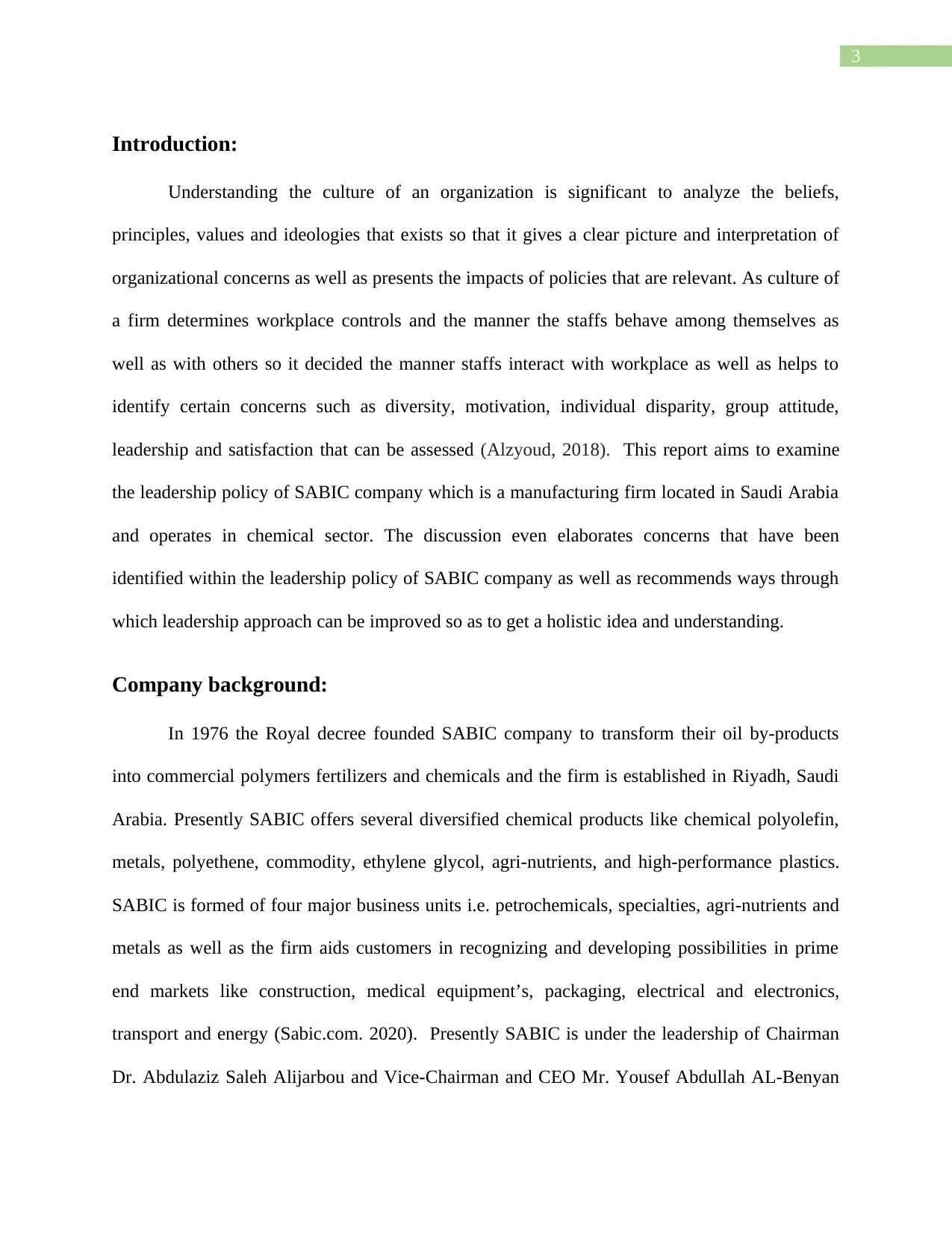
3
Introduction:
Understanding the culture of an organization is significant to analyze the beliefs,
principles, values and ideologies that exists so that it gives a clear picture and interpretation of
organizational concerns as well as presents the impacts of policies that are relevant. As culture of
a firm determines workplace controls and the manner the staffs behave among themselves as
well as with others so it decided the manner staffs interact with workplace as well as helps to
identify certain concerns such as diversity, motivation, individual disparity, group attitude,
leadership and satisfaction that can be assessed (Alzyoud, 2018). This report aims to examine
the leadership policy of SABIC company which is a manufacturing firm located in Saudi Arabia
and operates in chemical sector. The discussion even elaborates concerns that have been
identified within the leadership policy of SABIC company as well as recommends ways through
which leadership approach can be improved so as to get a holistic idea and understanding.
Company background:
In 1976 the Royal decree founded SABIC company to transform their oil by-products
into commercial polymers fertilizers and chemicals and the firm is established in Riyadh, Saudi
Arabia. Presently SABIC offers several diversified chemical products like chemical polyolefin,
metals, polyethene, commodity, ethylene glycol, agri-nutrients, and high-performance plastics.
SABIC is formed of four major business units i.e. petrochemicals, specialties, agri-nutrients and
metals as well as the firm aids customers in recognizing and developing possibilities in prime
end markets like construction, medical equipment’s, packaging, electrical and electronics,
transport and energy (Sabic.com. 2020). Presently SABIC is under the leadership of Chairman
Dr. Abdulaziz Saleh Alijarbou and Vice-Chairman and CEO Mr. Yousef Abdullah AL-Benyan
Introduction:
Understanding the culture of an organization is significant to analyze the beliefs,
principles, values and ideologies that exists so that it gives a clear picture and interpretation of
organizational concerns as well as presents the impacts of policies that are relevant. As culture of
a firm determines workplace controls and the manner the staffs behave among themselves as
well as with others so it decided the manner staffs interact with workplace as well as helps to
identify certain concerns such as diversity, motivation, individual disparity, group attitude,
leadership and satisfaction that can be assessed (Alzyoud, 2018). This report aims to examine
the leadership policy of SABIC company which is a manufacturing firm located in Saudi Arabia
and operates in chemical sector. The discussion even elaborates concerns that have been
identified within the leadership policy of SABIC company as well as recommends ways through
which leadership approach can be improved so as to get a holistic idea and understanding.
Company background:
In 1976 the Royal decree founded SABIC company to transform their oil by-products
into commercial polymers fertilizers and chemicals and the firm is established in Riyadh, Saudi
Arabia. Presently SABIC offers several diversified chemical products like chemical polyolefin,
metals, polyethene, commodity, ethylene glycol, agri-nutrients, and high-performance plastics.
SABIC is formed of four major business units i.e. petrochemicals, specialties, agri-nutrients and
metals as well as the firm aids customers in recognizing and developing possibilities in prime
end markets like construction, medical equipment’s, packaging, electrical and electronics,
transport and energy (Sabic.com. 2020). Presently SABIC is under the leadership of Chairman
Dr. Abdulaziz Saleh Alijarbou and Vice-Chairman and CEO Mr. Yousef Abdullah AL-Benyan
Paraphrase This Document
Need a fresh take? Get an instant paraphrase of this document with our AI Paraphraser
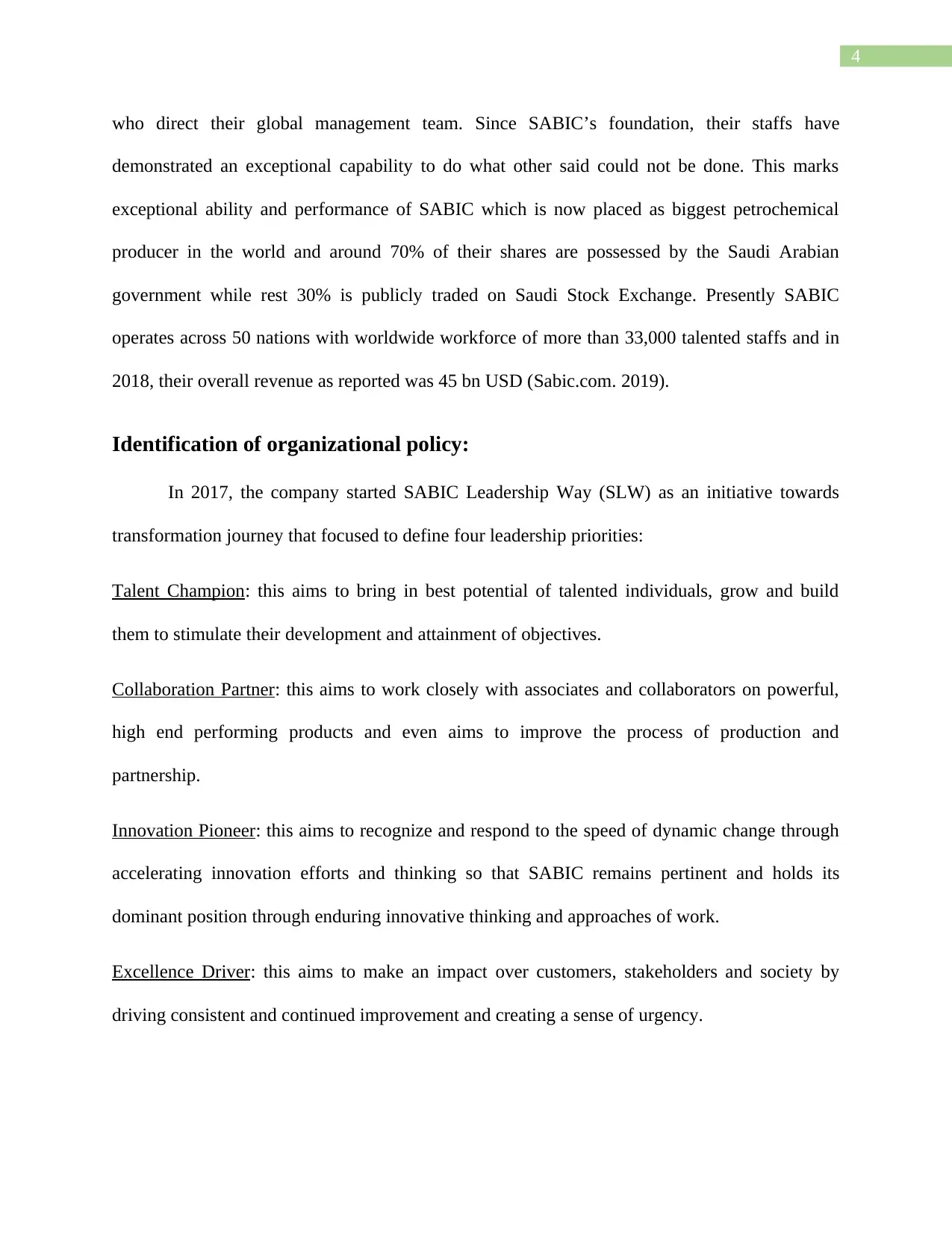
4
who direct their global management team. Since SABIC’s foundation, their staffs have
demonstrated an exceptional capability to do what other said could not be done. This marks
exceptional ability and performance of SABIC which is now placed as biggest petrochemical
producer in the world and around 70% of their shares are possessed by the Saudi Arabian
government while rest 30% is publicly traded on Saudi Stock Exchange. Presently SABIC
operates across 50 nations with worldwide workforce of more than 33,000 talented staffs and in
2018, their overall revenue as reported was 45 bn USD (Sabic.com. 2019).
Identification of organizational policy:
In 2017, the company started SABIC Leadership Way (SLW) as an initiative towards
transformation journey that focused to define four leadership priorities:
Talent Champion: this aims to bring in best potential of talented individuals, grow and build
them to stimulate their development and attainment of objectives.
Collaboration Partner: this aims to work closely with associates and collaborators on powerful,
high end performing products and even aims to improve the process of production and
partnership.
Innovation Pioneer: this aims to recognize and respond to the speed of dynamic change through
accelerating innovation efforts and thinking so that SABIC remains pertinent and holds its
dominant position through enduring innovative thinking and approaches of work.
Excellence Driver: this aims to make an impact over customers, stakeholders and society by
driving consistent and continued improvement and creating a sense of urgency.
who direct their global management team. Since SABIC’s foundation, their staffs have
demonstrated an exceptional capability to do what other said could not be done. This marks
exceptional ability and performance of SABIC which is now placed as biggest petrochemical
producer in the world and around 70% of their shares are possessed by the Saudi Arabian
government while rest 30% is publicly traded on Saudi Stock Exchange. Presently SABIC
operates across 50 nations with worldwide workforce of more than 33,000 talented staffs and in
2018, their overall revenue as reported was 45 bn USD (Sabic.com. 2019).
Identification of organizational policy:
In 2017, the company started SABIC Leadership Way (SLW) as an initiative towards
transformation journey that focused to define four leadership priorities:
Talent Champion: this aims to bring in best potential of talented individuals, grow and build
them to stimulate their development and attainment of objectives.
Collaboration Partner: this aims to work closely with associates and collaborators on powerful,
high end performing products and even aims to improve the process of production and
partnership.
Innovation Pioneer: this aims to recognize and respond to the speed of dynamic change through
accelerating innovation efforts and thinking so that SABIC remains pertinent and holds its
dominant position through enduring innovative thinking and approaches of work.
Excellence Driver: this aims to make an impact over customers, stakeholders and society by
driving consistent and continued improvement and creating a sense of urgency.
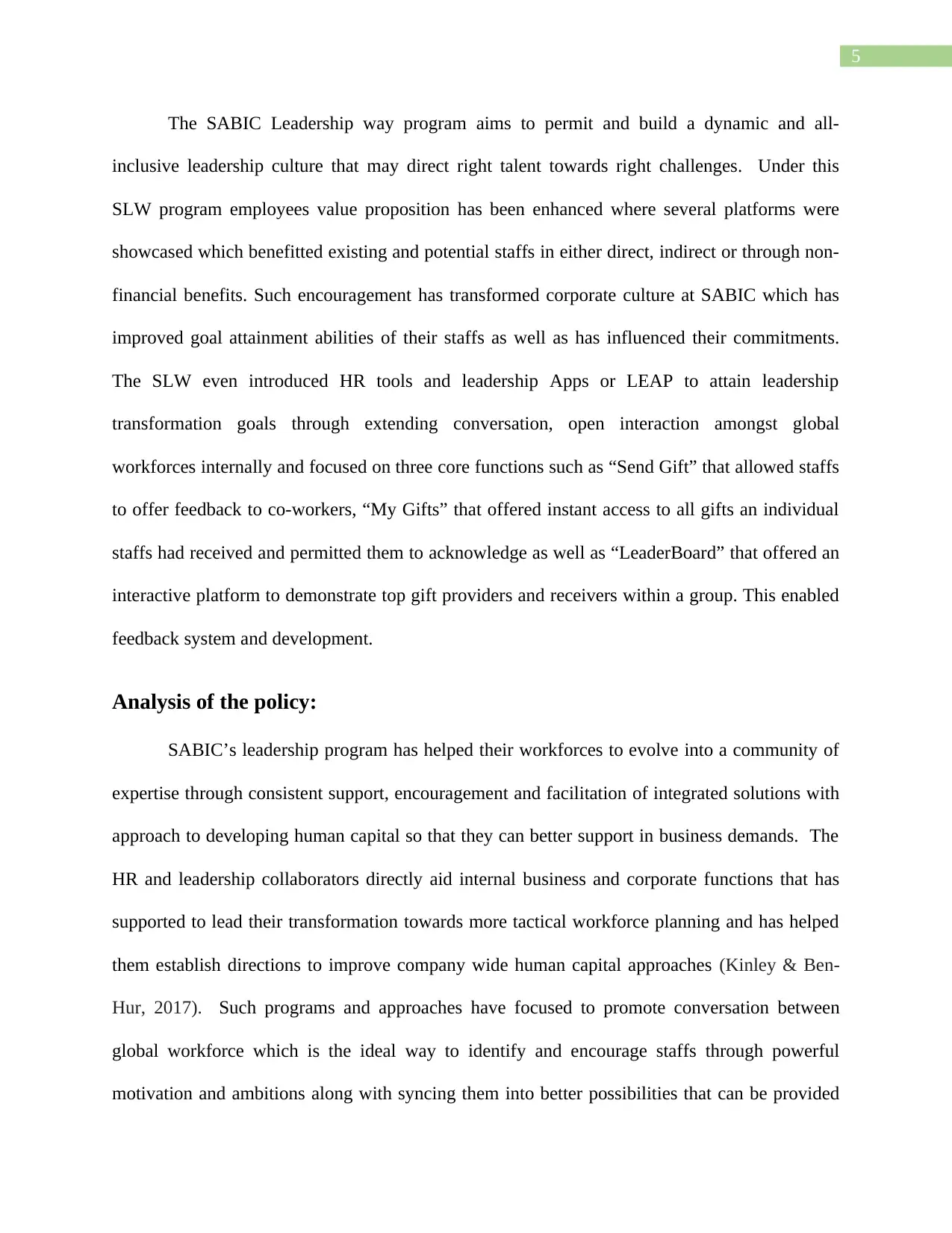
5
The SABIC Leadership way program aims to permit and build a dynamic and all-
inclusive leadership culture that may direct right talent towards right challenges. Under this
SLW program employees value proposition has been enhanced where several platforms were
showcased which benefitted existing and potential staffs in either direct, indirect or through non-
financial benefits. Such encouragement has transformed corporate culture at SABIC which has
improved goal attainment abilities of their staffs as well as has influenced their commitments.
The SLW even introduced HR tools and leadership Apps or LEAP to attain leadership
transformation goals through extending conversation, open interaction amongst global
workforces internally and focused on three core functions such as “Send Gift” that allowed staffs
to offer feedback to co-workers, “My Gifts” that offered instant access to all gifts an individual
staffs had received and permitted them to acknowledge as well as “LeaderBoard” that offered an
interactive platform to demonstrate top gift providers and receivers within a group. This enabled
feedback system and development.
Analysis of the policy:
SABIC’s leadership program has helped their workforces to evolve into a community of
expertise through consistent support, encouragement and facilitation of integrated solutions with
approach to developing human capital so that they can better support in business demands. The
HR and leadership collaborators directly aid internal business and corporate functions that has
supported to lead their transformation towards more tactical workforce planning and has helped
them establish directions to improve company wide human capital approaches (Kinley & Ben-
Hur, 2017). Such programs and approaches have focused to promote conversation between
global workforce which is the ideal way to identify and encourage staffs through powerful
motivation and ambitions along with syncing them into better possibilities that can be provided
The SABIC Leadership way program aims to permit and build a dynamic and all-
inclusive leadership culture that may direct right talent towards right challenges. Under this
SLW program employees value proposition has been enhanced where several platforms were
showcased which benefitted existing and potential staffs in either direct, indirect or through non-
financial benefits. Such encouragement has transformed corporate culture at SABIC which has
improved goal attainment abilities of their staffs as well as has influenced their commitments.
The SLW even introduced HR tools and leadership Apps or LEAP to attain leadership
transformation goals through extending conversation, open interaction amongst global
workforces internally and focused on three core functions such as “Send Gift” that allowed staffs
to offer feedback to co-workers, “My Gifts” that offered instant access to all gifts an individual
staffs had received and permitted them to acknowledge as well as “LeaderBoard” that offered an
interactive platform to demonstrate top gift providers and receivers within a group. This enabled
feedback system and development.
Analysis of the policy:
SABIC’s leadership program has helped their workforces to evolve into a community of
expertise through consistent support, encouragement and facilitation of integrated solutions with
approach to developing human capital so that they can better support in business demands. The
HR and leadership collaborators directly aid internal business and corporate functions that has
supported to lead their transformation towards more tactical workforce planning and has helped
them establish directions to improve company wide human capital approaches (Kinley & Ben-
Hur, 2017). Such programs and approaches have focused to promote conversation between
global workforce which is the ideal way to identify and encourage staffs through powerful
motivation and ambitions along with syncing them into better possibilities that can be provided
⊘ This is a preview!⊘
Do you want full access?
Subscribe today to unlock all pages.

Trusted by 1+ million students worldwide
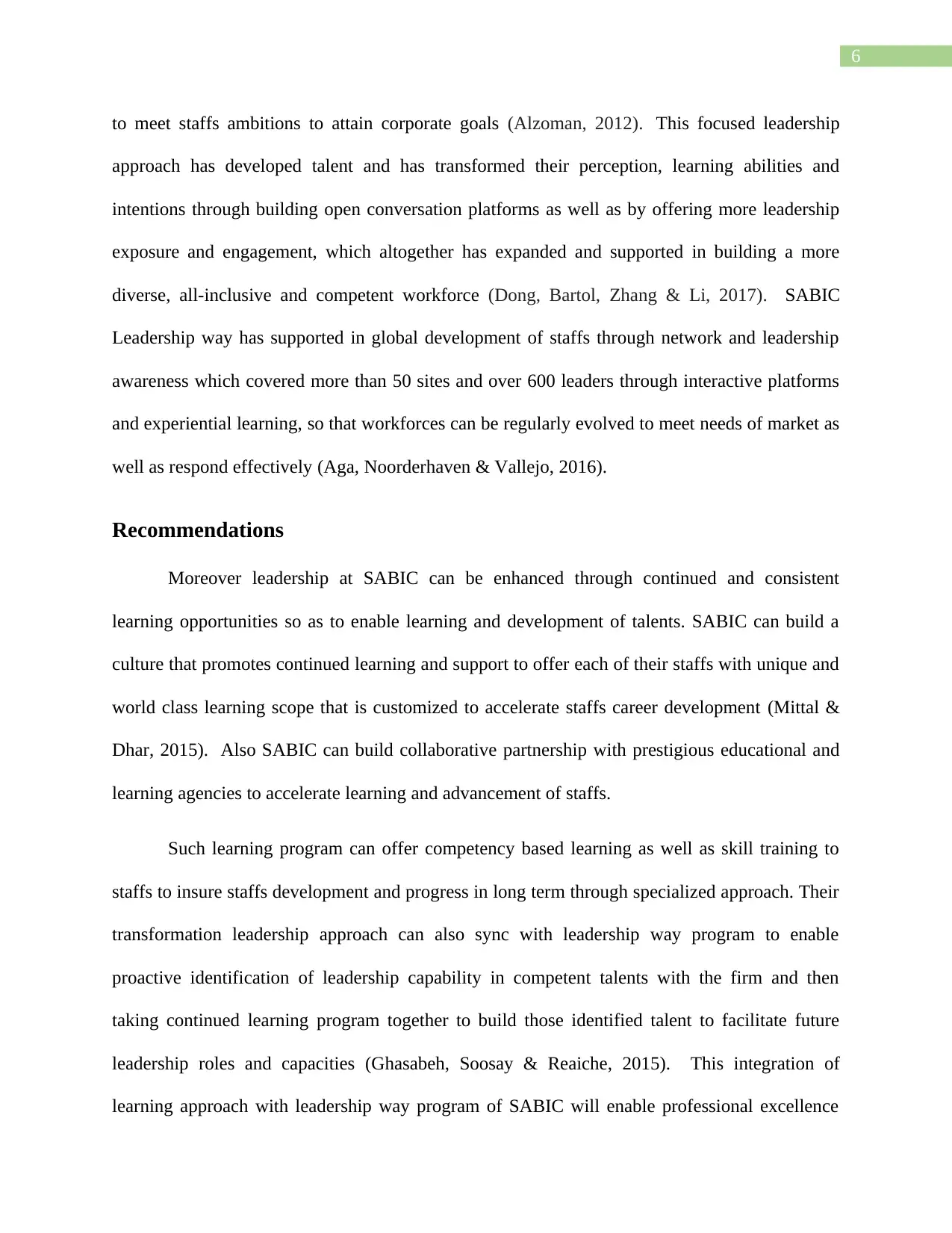
6
to meet staffs ambitions to attain corporate goals (Alzoman, 2012). This focused leadership
approach has developed talent and has transformed their perception, learning abilities and
intentions through building open conversation platforms as well as by offering more leadership
exposure and engagement, which altogether has expanded and supported in building a more
diverse, all-inclusive and competent workforce (Dong, Bartol, Zhang & Li, 2017). SABIC
Leadership way has supported in global development of staffs through network and leadership
awareness which covered more than 50 sites and over 600 leaders through interactive platforms
and experiential learning, so that workforces can be regularly evolved to meet needs of market as
well as respond effectively (Aga, Noorderhaven & Vallejo, 2016).
Recommendations
Moreover leadership at SABIC can be enhanced through continued and consistent
learning opportunities so as to enable learning and development of talents. SABIC can build a
culture that promotes continued learning and support to offer each of their staffs with unique and
world class learning scope that is customized to accelerate staffs career development (Mittal &
Dhar, 2015). Also SABIC can build collaborative partnership with prestigious educational and
learning agencies to accelerate learning and advancement of staffs.
Such learning program can offer competency based learning as well as skill training to
staffs to insure staffs development and progress in long term through specialized approach. Their
transformation leadership approach can also sync with leadership way program to enable
proactive identification of leadership capability in competent talents with the firm and then
taking continued learning program together to build those identified talent to facilitate future
leadership roles and capacities (Ghasabeh, Soosay & Reaiche, 2015). This integration of
learning approach with leadership way program of SABIC will enable professional excellence
to meet staffs ambitions to attain corporate goals (Alzoman, 2012). This focused leadership
approach has developed talent and has transformed their perception, learning abilities and
intentions through building open conversation platforms as well as by offering more leadership
exposure and engagement, which altogether has expanded and supported in building a more
diverse, all-inclusive and competent workforce (Dong, Bartol, Zhang & Li, 2017). SABIC
Leadership way has supported in global development of staffs through network and leadership
awareness which covered more than 50 sites and over 600 leaders through interactive platforms
and experiential learning, so that workforces can be regularly evolved to meet needs of market as
well as respond effectively (Aga, Noorderhaven & Vallejo, 2016).
Recommendations
Moreover leadership at SABIC can be enhanced through continued and consistent
learning opportunities so as to enable learning and development of talents. SABIC can build a
culture that promotes continued learning and support to offer each of their staffs with unique and
world class learning scope that is customized to accelerate staffs career development (Mittal &
Dhar, 2015). Also SABIC can build collaborative partnership with prestigious educational and
learning agencies to accelerate learning and advancement of staffs.
Such learning program can offer competency based learning as well as skill training to
staffs to insure staffs development and progress in long term through specialized approach. Their
transformation leadership approach can also sync with leadership way program to enable
proactive identification of leadership capability in competent talents with the firm and then
taking continued learning program together to build those identified talent to facilitate future
leadership roles and capacities (Ghasabeh, Soosay & Reaiche, 2015). This integration of
learning approach with leadership way program of SABIC will enable professional excellence
Paraphrase This Document
Need a fresh take? Get an instant paraphrase of this document with our AI Paraphraser
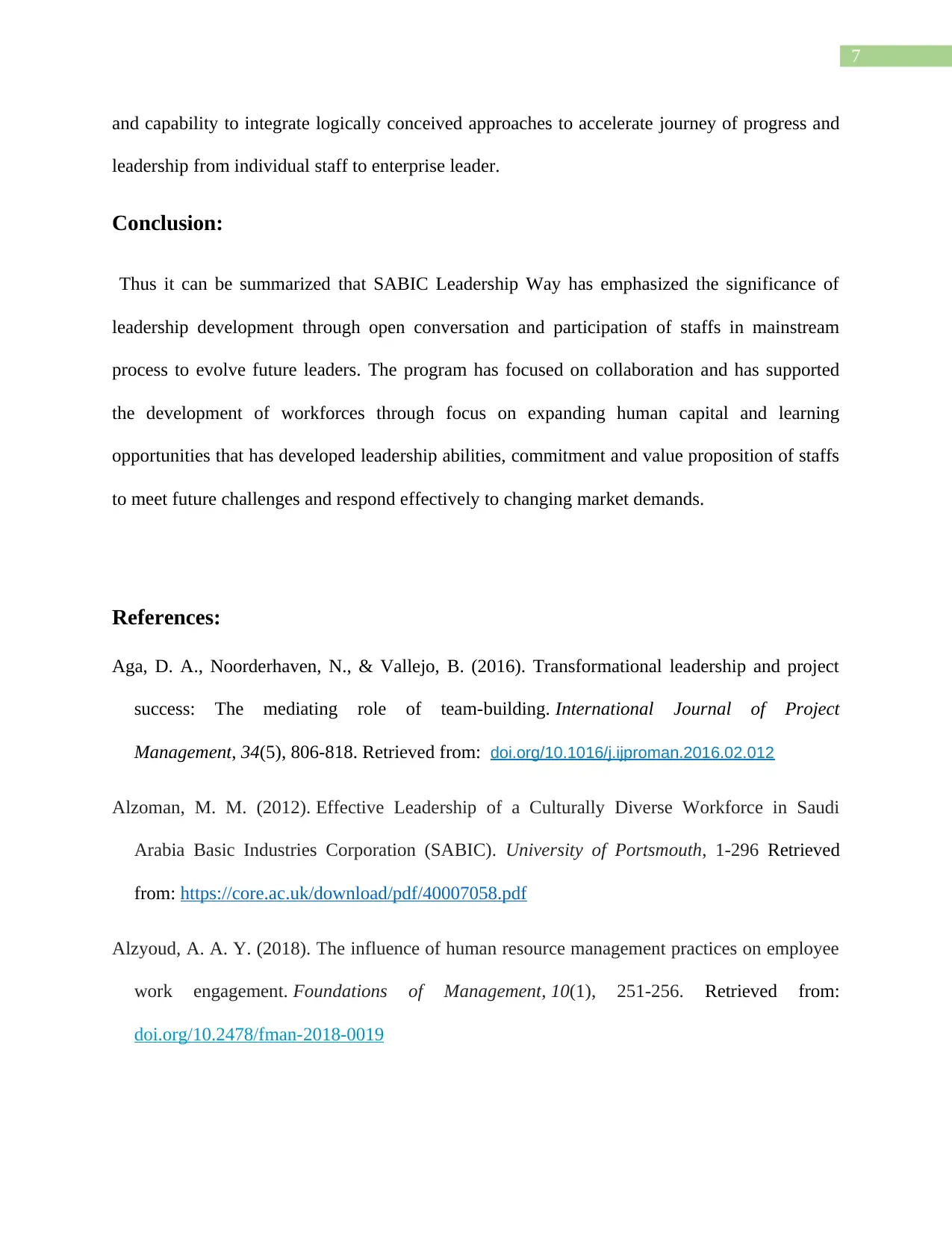
7
and capability to integrate logically conceived approaches to accelerate journey of progress and
leadership from individual staff to enterprise leader.
Conclusion:
Thus it can be summarized that SABIC Leadership Way has emphasized the significance of
leadership development through open conversation and participation of staffs in mainstream
process to evolve future leaders. The program has focused on collaboration and has supported
the development of workforces through focus on expanding human capital and learning
opportunities that has developed leadership abilities, commitment and value proposition of staffs
to meet future challenges and respond effectively to changing market demands.
References:
Aga, D. A., Noorderhaven, N., & Vallejo, B. (2016). Transformational leadership and project
success: The mediating role of team-building. International Journal of Project
Management, 34(5), 806-818. Retrieved from: doi.org/10.1016/j.ijproman.2016.02.012
Alzoman, M. M. (2012). Effective Leadership of a Culturally Diverse Workforce in Saudi
Arabia Basic Industries Corporation (SABIC). University of Portsmouth, 1-296 Retrieved
from: https://core.ac.uk/download/pdf/40007058.pdf
Alzyoud, A. A. Y. (2018). The influence of human resource management practices on employee
work engagement. Foundations of Management, 10(1), 251-256. Retrieved from:
doi.org/10.2478/fman-2018-0019
and capability to integrate logically conceived approaches to accelerate journey of progress and
leadership from individual staff to enterprise leader.
Conclusion:
Thus it can be summarized that SABIC Leadership Way has emphasized the significance of
leadership development through open conversation and participation of staffs in mainstream
process to evolve future leaders. The program has focused on collaboration and has supported
the development of workforces through focus on expanding human capital and learning
opportunities that has developed leadership abilities, commitment and value proposition of staffs
to meet future challenges and respond effectively to changing market demands.
References:
Aga, D. A., Noorderhaven, N., & Vallejo, B. (2016). Transformational leadership and project
success: The mediating role of team-building. International Journal of Project
Management, 34(5), 806-818. Retrieved from: doi.org/10.1016/j.ijproman.2016.02.012
Alzoman, M. M. (2012). Effective Leadership of a Culturally Diverse Workforce in Saudi
Arabia Basic Industries Corporation (SABIC). University of Portsmouth, 1-296 Retrieved
from: https://core.ac.uk/download/pdf/40007058.pdf
Alzyoud, A. A. Y. (2018). The influence of human resource management practices on employee
work engagement. Foundations of Management, 10(1), 251-256. Retrieved from:
doi.org/10.2478/fman-2018-0019
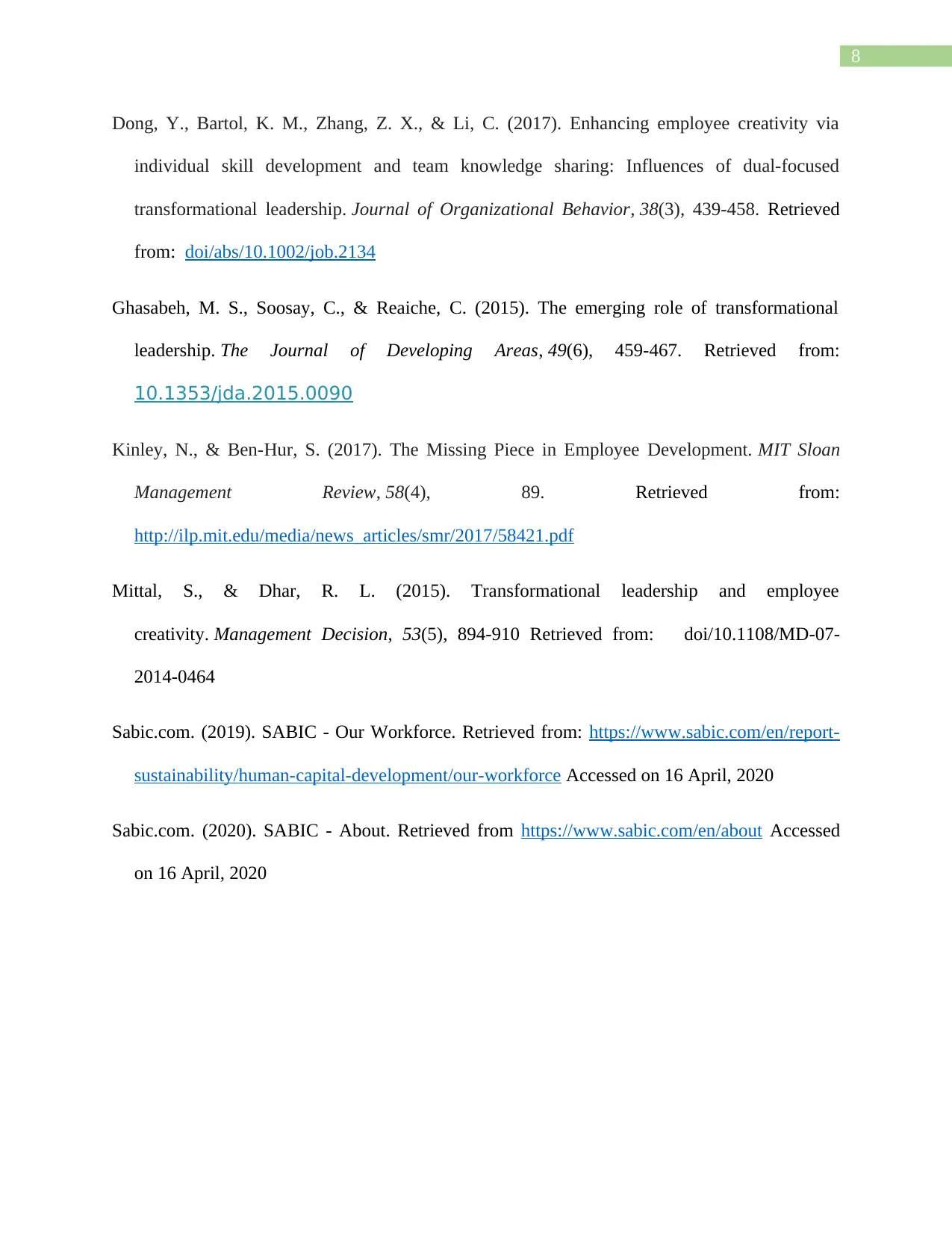
8
Dong, Y., Bartol, K. M., Zhang, Z. X., & Li, C. (2017). Enhancing employee creativity via
individual skill development and team knowledge sharing: Influences of dual‐focused
transformational leadership. Journal of Organizational Behavior, 38(3), 439-458. Retrieved
from: doi/abs/10.1002/job.2134
Ghasabeh, M. S., Soosay, C., & Reaiche, C. (2015). The emerging role of transformational
leadership. The Journal of Developing Areas, 49(6), 459-467. Retrieved from:
10.1353/jda.2015.0090
Kinley, N., & Ben-Hur, S. (2017). The Missing Piece in Employee Development. MIT Sloan
Management Review, 58(4), 89. Retrieved from:
http://ilp.mit.edu/media/news_articles/smr/2017/58421.pdf
Mittal, S., & Dhar, R. L. (2015). Transformational leadership and employee
creativity. Management Decision, 53(5), 894-910 Retrieved from: doi/10.1108/MD-07-
2014-0464
Sabic.com. (2019). SABIC - Our Workforce. Retrieved from: https://www.sabic.com/en/report-
sustainability/human-capital-development/our-workforce Accessed on 16 April, 2020
Sabic.com. (2020). SABIC - About. Retrieved from https://www.sabic.com/en/about Accessed
on 16 April, 2020
Dong, Y., Bartol, K. M., Zhang, Z. X., & Li, C. (2017). Enhancing employee creativity via
individual skill development and team knowledge sharing: Influences of dual‐focused
transformational leadership. Journal of Organizational Behavior, 38(3), 439-458. Retrieved
from: doi/abs/10.1002/job.2134
Ghasabeh, M. S., Soosay, C., & Reaiche, C. (2015). The emerging role of transformational
leadership. The Journal of Developing Areas, 49(6), 459-467. Retrieved from:
10.1353/jda.2015.0090
Kinley, N., & Ben-Hur, S. (2017). The Missing Piece in Employee Development. MIT Sloan
Management Review, 58(4), 89. Retrieved from:
http://ilp.mit.edu/media/news_articles/smr/2017/58421.pdf
Mittal, S., & Dhar, R. L. (2015). Transformational leadership and employee
creativity. Management Decision, 53(5), 894-910 Retrieved from: doi/10.1108/MD-07-
2014-0464
Sabic.com. (2019). SABIC - Our Workforce. Retrieved from: https://www.sabic.com/en/report-
sustainability/human-capital-development/our-workforce Accessed on 16 April, 2020
Sabic.com. (2020). SABIC - About. Retrieved from https://www.sabic.com/en/about Accessed
on 16 April, 2020
⊘ This is a preview!⊘
Do you want full access?
Subscribe today to unlock all pages.

Trusted by 1+ million students worldwide
1 out of 9
Related Documents
Your All-in-One AI-Powered Toolkit for Academic Success.
+13062052269
info@desklib.com
Available 24*7 on WhatsApp / Email
![[object Object]](/_next/static/media/star-bottom.7253800d.svg)
Unlock your academic potential
Copyright © 2020–2025 A2Z Services. All Rights Reserved. Developed and managed by ZUCOL.




